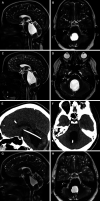Endoscopic placement of a triventricular stent for complex hydrocephalus and isolated fourth ventricle: illustrative case
- PMID: 37931250
- PMCID: PMC10631544
- DOI: 10.3171/CASE23153
Endoscopic placement of a triventricular stent for complex hydrocephalus and isolated fourth ventricle: illustrative case
Abstract
Background: Hydrocephalus is commonly encountered in pediatric neurosurgery. The etiology is diverse, and complexity in management increases in patients with loculated or trapped ventricles. The authors sought to examine a treatment option of endoscopic placement of a triventricular stent in a pediatric patient with complex hydrocephalus and a trapped fourth ventricle.
Observations: In this case, the authors present the treatment of complex hydrocephalus with a trapped fourth ventricle in a pediatric patient using endoscopic placement of a triventricular aqueductal stent. The patient had a complex neurosurgical history, which included over 15 surgeries for shunted hydrocephalus. This case highlights the unique approach used, and the authors discuss surgical nuances of the technique, as well as learning points.
Lessons: Complex hydrocephalus can be difficult to manage because patients often have multiple catheters, loculated or trapped ventricles, and extensive surgical histories. Endoscopic placement of a triventricular stent can decrease shunt system complexity, restore normal cerebrospinal fluid pathway circulation across the cerebral aqueduct, and promote communication between the ventricles. The authors' treatment modality resulted in the successful resolution of the trapped fourth ventricle and symptomatic improvement in hydrocephalus.
Keywords: aqueductal stent; complex hydrocephalus; pediatric neurosurgery; trapped fourth ventricle.
Conflict of interest statement
Figures



References
-
- Ferrer E, de Notaris M. Third ventriculostomy and fourth ventricle outlets obstruction. World Neurosurg. 2013;79(2 Suppl):S20.e9–e13. - PubMed
-
- Bock HC, Dreha-Kulaczewski SF, Alaid A, Gärtner J, Ludwig HC. Upward movement of cerebrospinal fluid in obstructive hydrocephalus—revision of an old concept. Childs Nerv Syst. 2019;35(5):833–841. - PubMed
-
- Peraio S, Amen MM, Ali NM, Zaher A, Mohamed Taha AN, Tamburrini G. Endoscopic management of pediatric complex hydrocephalus. World Neurosurg. 2018;119:e482–e490. - PubMed
LinkOut - more resources
Full Text Sources

